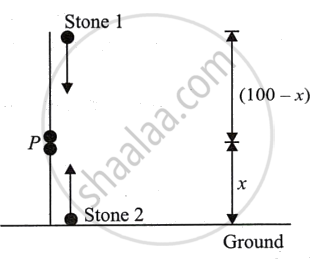Advertisements
Advertisements
प्रश्न
A stone is allowed to fall from the top of a tower 100 m high and at the same time another stone is projected vertically upwards from the ground with a velocity of 25 m/s. Calculate when and where the two stones will meet.
उत्तर
Here, h = 100 m
Let the two stones meet after t seconds at point P, which is at a height x above the ground, as shown in the figure.

For stone 1,
u = 0, h = (100 - x) m,
a = g = 9.8 m/s2
From s = `ut + 1/2 at^2`
(100 - x) = `0 + 1/2 xx 9.8 t^2`
= 4.9t2 ...(i)
For stone 2,
u = 25 m/s, h = x,
a = - g = - 9.8 m/s2
From s = `ut + 1/2 at^2`
x = `25t + 1/2 (-9.8)t^2`
= 25t - 4.9t2 ...(ii)
Adding equations (i) and (ii)
100 - x + x = 25t
⇒ t = `100/25`
= 4 s
From equation (i),
100 - x = 4.9 × (4)2
100 - x = 78.4
x = 100 - 78.4
x = 21.6 m
APPEARS IN
संबंधित प्रश्न
What do you mean by acceleration due to gravity?
Gravitational force acts on all objects in proportion to their masses. Why then, a heavy object does not fall faster than a light object?
What is the acceleration of free fall?
Which force is responsible for the moon revolving round the earth ?
Explain what is meant by the equation :
`g= Gxxm/r^2`
where the symbols have their usual meanings.
Explain why, the tip of a sewing needle is sharp.
A ball falls off a table and reaches the ground in 1 s. Assuming g=10 m/s2, calculate its speed on reaching the ground and the height of the table.
A force of 15 N acts on a body of mass 2 kg. Calculate the acceleration produced.
In vacuum, all freely falling objects have the same force. Is it true?
Free fall of an object does not depend on the mass of the object.
